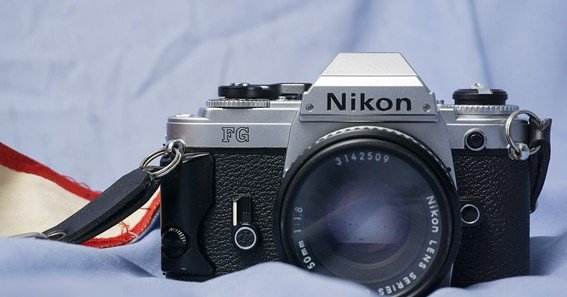The Nikon FG, introduced in 1982, holds the distinction of being Nikon’s first 35mm SLR camera to feature both programmed auto-exposure (AE) and through-the-lens (TTL) flash metering. This compact and lightweight camera was designed to cater to both amateur and intermediate photographers, offering a blend of automation and manual control.
Key Features of the Nikon FG
-
Exposure Modes: The FG offers three exposure modes—Programmed AE, Aperture Priority AE, and Manual—providing flexibility for various shooting scenarios.
-
TTL Flash Metering: As Nikon’s first camera with TTL off-the-film (OTF) flash metering, the FG ensures accurate flash exposures by measuring light directly at the film plane.
-
Compact Design: Weighing approximately 490 grams, the FG’s compact and lightweight build makes it an excellent choice for photographers seeking portability without sacrificing functionality.
-
Viewfinder Display: The viewfinder features a clear display with a vertical shutter speed scale and LED indicators, aiding photographers in making precise exposure adjustments.
Performance and User Experience
Photographers have praised the Nikon FG for its reliable performance and user-friendly interface. Its ability to seamlessly switch between automated and manual modes allows users to exercise creative control while benefiting from technological assistance when needed. The TTL flash metering system enhances flash photography by delivering consistent and accurate exposures.
However, some users have noted that, despite its capabilities, the FG may lack the excitement found in other Nikon models. While it is functional and accurate, it might not evoke the same enthusiasm among all photographers.
Pros and Cons
Pros:
-
Versatile Exposure Modes: The inclusion of Programmed AE, Aperture Priority, and Manual modes caters to both beginners and experienced photographers.
-
Accurate Flash Exposure: The TTL flash metering system simplifies flash photography, ensuring well-exposed images.
-
Portability: Its lightweight and compact design make it convenient for on-the-go photography.
Cons:
-
Build Quality: The extensive use of polycarbonate materials, while reducing weight, may not offer the same durability as Nikon’s professional-grade cameras.
-
Limited Shutter Speed Range: With a maximum shutter speed of 1/1000s, the FG may be limiting for photographers requiring faster speeds.
FAQ
1. Is the Nikon FG suitable for beginners?
Yes, the Nikon FG’s Programmed AE mode allows beginners to capture well-exposed images without manual adjustments, while Aperture Priority and Manual modes provide room for growth.
2. Can I use modern Nikon lenses with the FG?
The FG is compatible with Nikon F-mount lenses that support automatic indexing (AI). However, it may not function properly with newer lenses lacking an aperture ring.
3. Does the Nikon FG require batteries to operate?
Yes, the FG relies on two SR44 or LR44 batteries to power its electronic shutter and metering systems. Without batteries, only the mechanical ‘M90’ (1/90s) and bulb (B) shutter settings are operational.
4. What accessories are available for the Nikon FG?
Accessories include motor drives like the MD-14 and MD-E for automatic film advance, and the MF-15 databack for imprinting date and time on photos.
5. How does the Nikon FG compare to the Nikon FG-20?
The FG-20 is a simplified version of the FG, lacking Programmed AE mode and TTL flash metering. It also omits the exposure compensation dial but retains Aperture Priority and Manual modes.
In conclusion, the Nikon FG stands as a notable example of Nikon’s innovation during the early 1980s, blending automation with manual control in a compact form factor. While it may not evoke excitement for all users, its functionality and versatility make it a worthy consideration for those seeking a reliable film SLR camera.
Read on to know more about jts-12-gauge-ak










